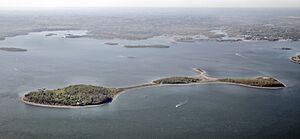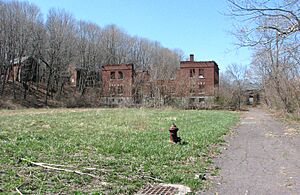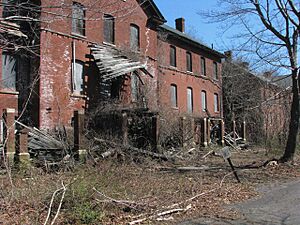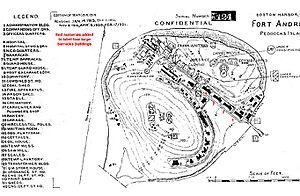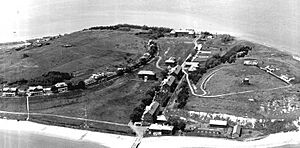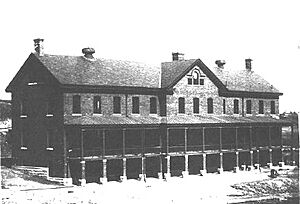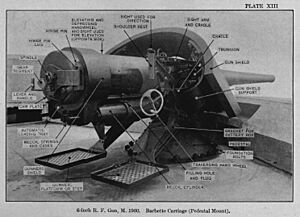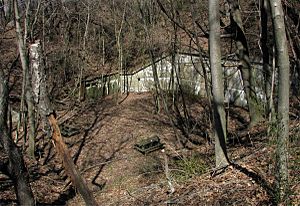Fort Andrews facts for kids
Quick facts for kids Fort Andrews |
|
|---|---|
| Part of Harbor Defenses of Boston | |
| Peddock's Island, Massachusetts | |

At the height of its armament, the fort had 16 M1896 mortars as shown, in 4 pits of four mortars each. In 1910 four of these were sent to the Philippines; these were replaced by four M1908 mortars. Later 6 mortars (2 from each of 3 pits) were removed. This photo most likely depicts Pit A of Battery Cushing at Fort Andrews.
|
|
|
Location in Massachusetts
|
|
| Coordinates | 42°18′06″N 70°55′53″W / 42.30167°N 70.93139°W |
| Type | Coastal Defense, later POW camp |
| Site information | |
| Owner | Boston Harbor Islands National Recreation Area |
| Open to the public |
yes |
| Site history | |
| Built | 1898-1904 |
| Built by | United States Army |
| In use | 1901-1947 |
| Battles/wars | World War I World War II |
Fort Andrews was a military base built in 1897 to protect Boston Harbor in Massachusetts. Construction started in 1898 and was mostly finished by 1904. The fort was named after Major General George Leonard Andrews, a Civil War hero and engineer. He helped build another fort nearby, Fort Warren.
Fort Andrews is located on the northeast end of Peddocks Island in Boston Harbor. It was first called the Peddocks Island Military Reservation. This fort was once a busy place with hundreds of soldiers. It had many powerful guns and mortars. These weapons guarded the southern entrances to Boston and Quincy Bay. During World War II, the fort also held Italian prisoners of war. They worked as laborers after Italy surrendered in 1943. Today, Fort Andrews is abandoned. The Massachusetts Department of Conservation and Recreation manages it as part of the Boston Harbor Islands National Recreation Area.
Powerful Guns and Mortars
Fort Andrews was armed with many large guns and mortars. These were designed to protect Boston from enemy ships. Here are the main gun batteries that were built at the fort:
| Name | Number of Guns | Gun Type | Years Active |
|---|---|---|---|
| Cushing | 8 | 12-inch coast defense mortar M1890 | 1904-1942 |
| Whitman | 8 | 12-inch coast defense mortar M1890 | 1902-1942 |
| McCook | 2 | 6-inch gun M1900 | 1904-1947 |
| Rice | 2 | 5-inch gun M1900 | 1909-1917 |
| Bumpus | 2 | 3-inch gun M1902 | 1905-1946 |
In its busiest years, Fort Andrews had very impressive weapons. It was one of two places in Boston Harbor with huge 12-inch coast defense mortars. These mortars were designed to protect the southern water routes into Boston. Each mortar could fire a projectile weighing over 1,000 pounds! They could hit targets up to 7 miles away. Their fire combined with mortars from Fort Banks to create a strong defense.
Originally, there were plans for 16 mortars in four pits. However, only two pits were built for Battery Whitman and two for Battery Cushing. When fully armed, these pits held 16 large mortars. They could bombard the southern approaches to the harbor. Three of the original mortar pits are still visible today. The fourth pit has been partly filled with rubble from other buildings that were torn down.
The local newspapers reported on the power of these mortars. When they were test-fired in the 1920s, the blasts were so strong they blew doors off nearby barracks buildings. They also broke windows at the fort! Island residents even said the blasts from the mortar barrels sometimes started brush fires on the grassy slopes of the pits.
Besides the mortars, Fort Andrews also had two 6-inch guns in Battery McCook. Until 1917, it had two 5-inch guns in Battery Rice. There were also two 3-inch guns in Battery Bumpus. These guns were placed in concrete spots on a bluff overlooking the main channel to Quincy Bay. You can still see these gun emplacements today, but they are old and can be dangerous to visit.
Fort Andrews Through Time
Fort Andrews was built between 1898 and 1904. It was part of a large project called the Endicott program. This program built many new forts, including seven in the Boston area. Fort Andrews was one of the two largest forts of its kind in Boston Harbor. The other was Fort Strong on Long Island. After Fort Strong's wooden buildings were mostly removed around 2005, Fort Andrews became the only fort of its type left in Massachusetts.
In 1910, four of the M1890 mortars from Battery Whitman were moved. They were sent to Battery Geary at Fort Mills in the Philippines. By 1913, Battery Whitman was rearmed with newer M1908 mortars.
World War I brought more changes to Fort Andrews' weapons. In 1917, Battery Rice's two 5-inch guns were moved to Fort Story in Virginia. These guns were never replaced. In 1917, Battery McCook's two 6-inch guns were ordered to be removed. The idea was to use them on wheeled carriages on the Western Front in Europe. However, it seems these guns never left the fort. They were put back in place in 1920.
Also, almost half of Fort Andrews' mortars were removed in early 1918. It was found that trying to reload four mortars in one pit at the same time was not efficient. A similar firing rate could be achieved with only two mortars per pit. Many 12-inch mortars were also needed as railway artillery for potential use on the Western Front. None of these mortars made it to France before the war ended. However, many were kept as railway mortars through World War II. As a result, Battery Cushing was reduced to four mortars, and Battery Whitman had six mortars.
By the 1920s, Fort Andrews had about 30 buildings. These included large brick barracks that could house over 100 soldiers each. There were also fancy officers' quarters and a hospital with 50 beds. The fort even had one of the Army's first radio transmitting stations.
After World War I, Fort Andrews was put into "caretaker status," meaning it was mostly shut down. It was brought back into action for World War II. By the 1930s, the fort's mortars were less important. Newer, long-range guns at Fort Ruckman and Fort Duvall took over. In 1942, the fort's huge mortars were scrapped. However, its 6-inch and 3-inch guns continued to guard the southern entrances to Boston Harbor throughout the war. As mentioned, the fort also served as a prisoner-of-war camp for Italian prisoners during World War II. They worked as laborers after Italy surrendered to the Allies in 1943.
In 1946, the Army officially closed Fort Andrews. In the 1970s, the Commonwealth of Massachusetts bought it, along with the rest of Peddocks Island.
By 2010, most of the fort's buildings were in very bad shape or collapsing. Peddocks Island, which you can usually reach by ferry, was temporarily closed to the public. The island reopened on July 8, 2011.
Spotting the Enemy: Fire Control Buildings
Fort Andrews had many different types of buildings for "fire control." These buildings helped soldiers figure out where enemy ships were. They also helped them aim the fort's guns and mortars. These special structures were built starting in 1904 and continued to be added through World War II.
One of the oldest fire control buildings is on the East Side. It was finished in 1904. This building was high up on a hill, giving it a great view of the southern harbor channels and the sea. It originally had equipment to help aim Battery McCook's guns. It also had observation tools for the fort's commander and a "plotting room" to calculate targets.
Another East Side fire control station was a "coincidence range finder" (CRF) station. This was in a small blockhouse built in 1925. It was on the gun platform for Battery Rice, a 5-inch battery that never received its guns. This small building held a special device that helped measure the distance to enemy ships.
A third fire control station on the East Side, also built in 1925, was a small "pillbox" building. It held a "depression position finder" (DPF) for Battery McCook. This spot was near the edge of the tall northern bluffs of the island. It offered a clear view towards Fort Warren on Georges Island and the channels leading into Boston.
On the tall hill on the west side of the parade ground, there were two more stations. In 1944, a concrete bunker was built. It housed a "base end station" for Battery McCook. This structure was 128 feet above sea level and held a DPF. Today, this building is covered in trees and bushes. But during World War II, the area was kept clear so soldiers could see far away.
The last fire control building was a two-room wooden building built in 1907. It had observation platforms and plotting rooms for the mortar batteries Whitman and Cushing. This building has now collapsed under fallen trees, and its remaining walls are shaky. It was built in a deep pit, so only its observation windows likely stuck out above ground. These ruins are important because they are the only remains of an early type of wooden fire control building used in Boston's harbor defenses.



